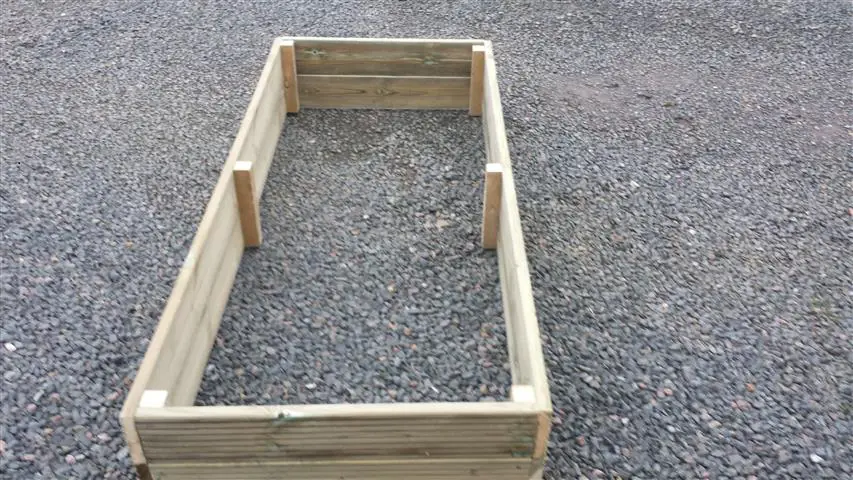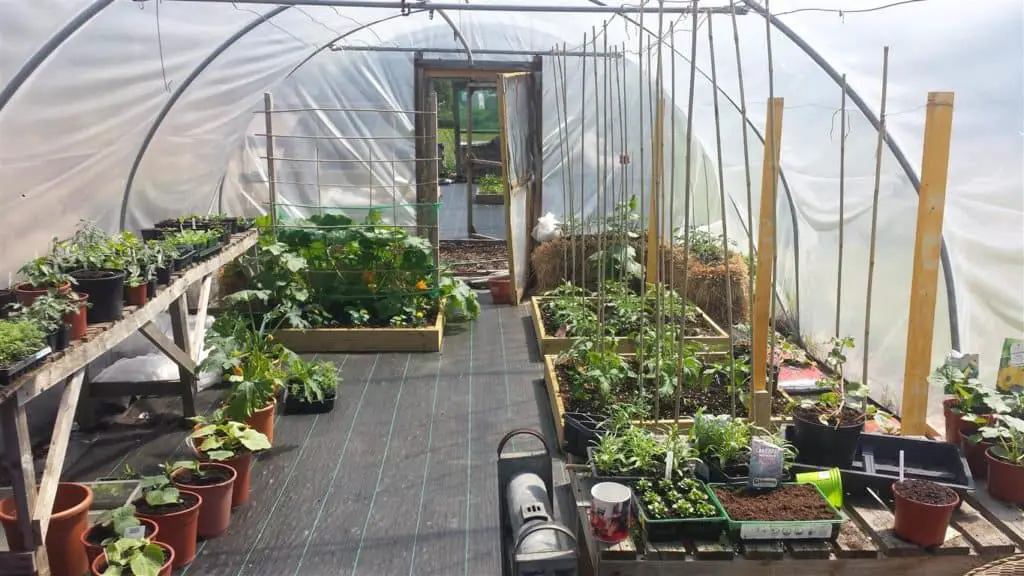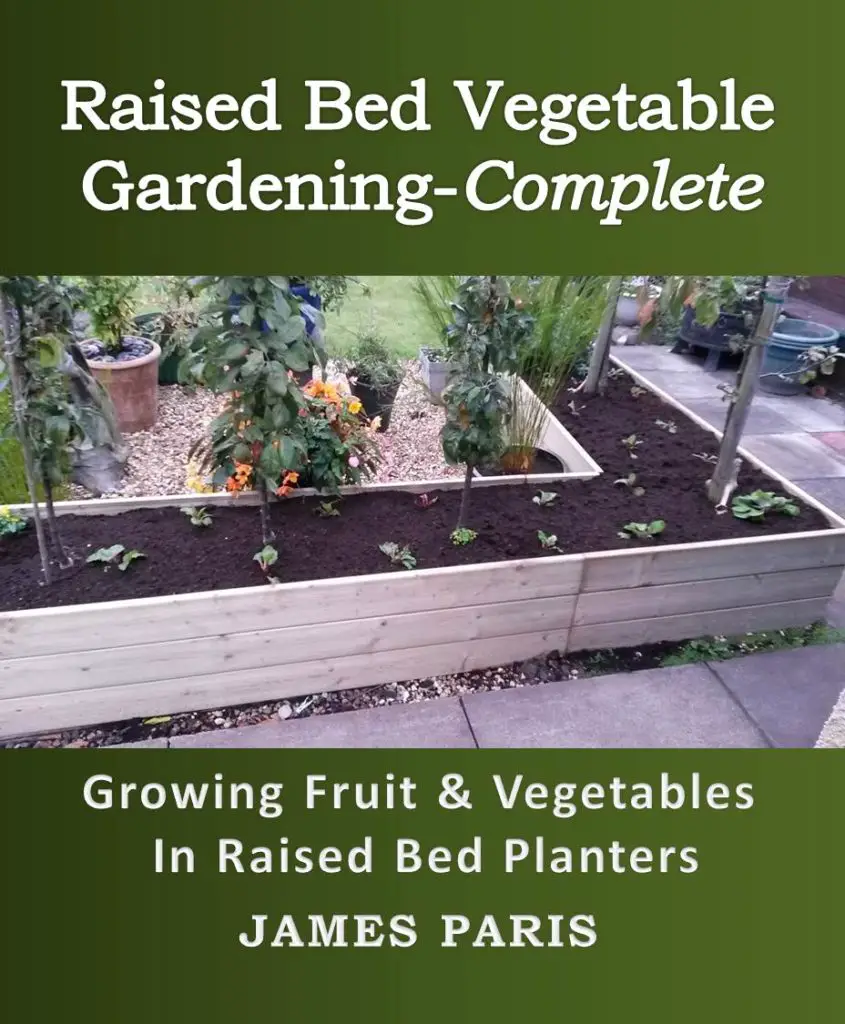Please do not get too hung up over the actual construction of the Raised Bed – It’s not rocket science – no matter what some ‘experts’ would say!
Apart from a traditional timber construction; over the years I have seen Raised Beds built from corrugated metal sheeting, sandbags, concrete, cinder blocks, bricks ( laid dry or with mortar), and even straw!
There is in fact another type of Raised bed garden that combines both techniques, but has to be built every 2 years or so as the straw bales collapse into themselves – although this does make a great mix for the compost heap!
Rather than build a permanent Raised Bed, this straw bale arrangement is simply filled in with soil/compost mix to form a complete growing area.

Also you are limited to the central space, as you definitely cannot stand on the bales to reach the center of the growing area! With the bale already taking up 14 inches of width, any more than 18-24 inches of a central channel, means a real stretch to reach the veggies growing in the center.
If you like this idea but would like it to last a little longer, then simply build a wooden frame around it to keep the bales in place. This way you will get at least 3 years growing out of it.
Ok, with all that said. All you are doing, no matter what materials you decide to use, is simply to create an open box or frame in order to fill it with a good growing medium.

You’re not trying to re-invent the wheel. It is not difficult, and does not even have to be pretty. 4 sides, no base, no top – a framework anything from 6 – 24 inches high.
The main criteria for the actual construction, is that is robust enough to be ‘good for purpose’ In other words it will not fall apart when you infill it, or indeed as you use it over the growing season!
An ideal size as mentioned earlier is 6 foot x 3 x 18 inches high. This allows easy access with minimum bending over for servicing, and easy access from a wheelchair.

As for timber dimensions. 6 inch x 2 inch boards either treated or untreated are ideal, although 1 inch thick will do ok with a little extra support. Decking material – such has been used in the picture above – can be a good choice for this.
A 3 inch x 3 inch post at each corner and one in the center of the long side, is enough to give a robust construction on a 6 foot frame. These posts can be hammered down into the ground to add extra rigidity.
If using a timber construction rather than a modular steel bed, a good tip is to line the inside with a black polythene membrane. This will prevent any contamination leeching into the compost from treated timber. It will also prevent the timber from soaking up the moisture from the infill material.
When building a deep bed 18 inches and over, unless you need the actual depth of soil for deep rooted vegetables then fill in the first 6 inches or so with stones, old timbers, or gravel, to cut down on the cost on filling it with expensive compost.
The Best Infill Mix For A Raised Bed:
The ‘big secret’ for getting great results with a Raised Bed garden (amazon book) or indeed any kind of container garden, is to use very little or zero % topsoil.
(amazon book) or indeed any kind of container garden, is to use very little or zero % topsoil.
There are a number of reasons for not including a lot of topsoil in a Raised Bed including the following.
1: Topsoil tends to compact in a Raised Bed garden. This makes it difficult to cultivate and it creates a poor growing medium for the plants as they struggle to break through the compacted soil.
2. Adding topsoil to the bed also means that you are adding weed seeds and pests that have hidden themselves away in the soil, only to arise when the conditions are good for them – like when your vegetables are trying to establish themselves!
3: One of the main ‘selling points’ for using a Raised Bed is that it offers a ‘no-dig solution to gardening. As mentioned in point 1 the topsoil tends to compact and create a growing area that has to be broken up again using a garden fork or spade.
A properly infilled Raised Bed should only require the use of small hand tools to maintain the growing area.
4: By avoiding the use of topsoil and filling the bed with the proper mix of ingredients, there is much less need for fertilizers.
This is because you have created a nutrient-rich environment for the plants to grow. It also means that because of this healthy growing environment, the plants can be grown closer together to produce more abundant crops.
5: The absence of weed-seeds – at least for most of the first growing season – means that your plants are not fighting weeds for the nutrients or the water they need to prosper.
Any weeds that do eventually grow up, are very easily removed from the loose growing medium that you have created.

Filling The Raised Bed Soil/Compost Mix:
By now you no doubt get the idea – the infill material has to be right if you are to get the best results from your labours! And this means a mix of topsoil, compost, vermiculite , sand and peat. Not everything in this list is needed – check out the mixes below.
, sand and peat. Not everything in this list is needed – check out the mixes below.
Again, this is not some great alchemists ‘secret sauce’ recipe that is the privilege of the chosen few celebrity gardeners. All you are attempting to create is a nutrient-rich, moist, but free draining growing environment.
This will produce great results for about 95% of all vegetables; the rest grow in the dark or in a bog!
Ok, a bit of an exaggeration, but you get the idea I think 🙂
There are a few of these mixes that will produce great results, but do not be afraid to ‘mix and mingle’ according to what you can get your hands on.
Coconut fibre can be a good substitute if you are not comfortable using peat for instance, and pearlite is a cheaper substitute for vermiculite which can be expensive and difficult to obtain in some areas.

Here are some examples of growing mixes for a Raised Bed or container garden.
Mix 1: 1/3rd compost. 1/3rd peat, 1/3rd vermiculite or pearlite.
Mix 2: ½ compost, ¼ sand, ¼ peat.
Mix 3: 1/3rd compost, 1/3rd sphagnum moss, 1/3rd sand.
Mix 4: ½ compost, ¼ sand, ¼ vermiculite
When making up your mix, consider that you are adding nutrients with the compost. Drainage with the sand, and water/nutrient retention properties along with friability with the vermiculite, peat, and sphagnum moss.
An ideal potting mix for growing seeds is simply ½ compost to ½ sand. This simple mix is perfectly acceptable for the vast majority of vegetable seeds to germinate and grow to healthy seedlings.
As for the depth of your Raised Bed. Consider the vegetables you are growing, whether they need depth to grow properly. Tap root veg like carrots or parsnips need at least 12-18 inches of soil, whereas cabbages, onions, beetroot etc, can grow well in only six inches or so.
Finally, feel free to experiment with your infill mix, especially if you make your own compost. If you have exceptionally good topsoil then don’t be afraid to include more in the mix – just look out for the ‘compacting’ effect if the soil has too much clay content for example.

